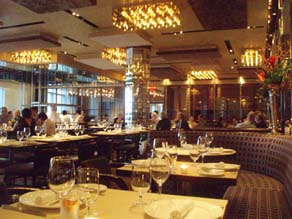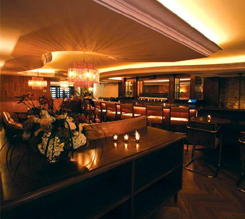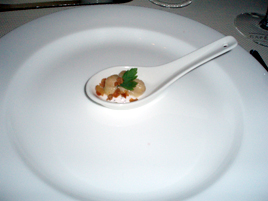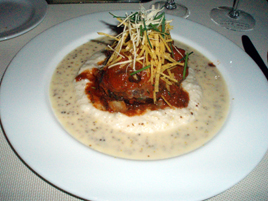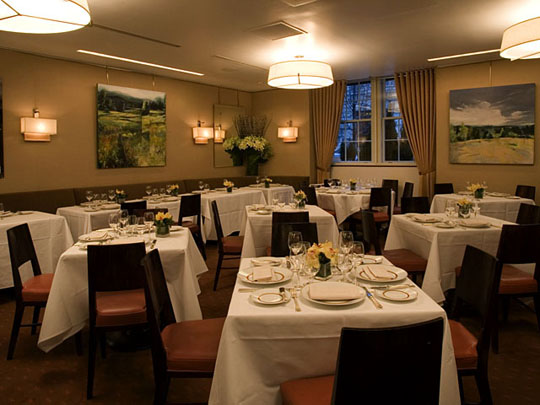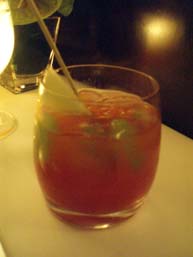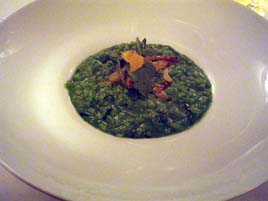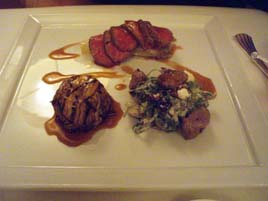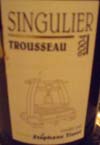

When I heard that Wayne Nish was serving “three-star bar food” at a Lower East Side gastropub, I was a little skeptical.
Guess what? He has pulled it off.
Spitzer’s Corner, which opened in August 2007, had a tough first nine months, with a revolving door in the kitchen. Nish is the fourth chef. The early reviews found his predecessors’ menus underwhelming, and it’s tough get the critics back for a second look.
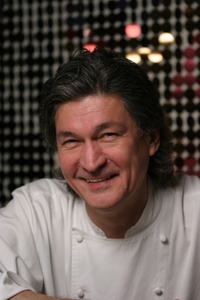
Wayne Nish
They should come back, because Nish’s menu at Spitzer’s corner is remarkable. Although Nish is billed only as a “consultant,” his hand-picked chef de cuisine, Sung Park, has serious credentials, with stints under Jean-Georges Vongerichten, Didier Virot, and Laurent Tourondel under his belt. He was also Nish’s chef de cuisine for the short-lived second act at Varietal.
And Park is no absentee chef: he was there on a Saturday night.
When I think about the food here, the closest comparison that comes to mind is Momofuku Ssäm Bar. Both restaurants offer sophisticated cooking with luxury ingredients in a laid-back, pared down environment. Park seemed taken aback when I mentioned the similarity, as David Chang’s food has an Asian tang, while Nish and Park come from the French tradition. But once I explained myself, he seemed to agree that the analogy was valid.
The foodies haven’t descended on Spitzer’s Corner as they’ve done at the Momofuku restaurants, but it’s not struggling either. The Saturday evening business was fairly brisk. The restaurant seats 130 and is open daily for lunch and dinner, with food served until 2:00 a.m. There is also Saturday and Sunday brunch.
 The menu is inexpensive. A section called “Bar Snacks and Sides” features eight items priced from $4–10, while a section called “Plates,” corresponding roughly to appetizers and entrées, has fifteen selections from $9–17. Most items are suitable for sharing.
The menu is inexpensive. A section called “Bar Snacks and Sides” features eight items priced from $4–10, while a section called “Plates,” corresponding roughly to appetizers and entrées, has fifteen selections from $9–17. Most items are suitable for sharing.
The aesthetic is pared down, with most of the seating at long communal tables. (There are a few two-tops.) The wood that lines the walls is alleged to have been made from reclaimed pickle barrels. There are broad picture windows, which on a warm evening are open to the outside.
The name, by the way, comes from a dress shop that formerly occupied the space. It has nothing to do with Eliot Spitzer, the disgraced former governor of New York.
They don’t have a hard liquor license, but there are 40 beers on tap and another 40 in bottles. They’re listed on the menu with brief tasting notes, as you’d find on a wine list (“Epic malts, spicy notes w/ hints of baker’s choc”).
 They aren’t just the obvious beers, either. There couldn’t be many places in town serving Delirium Tremens, Victory Golden Monkey, Stone Arrogant Bastard, or Rogue Dead Guy Ale. The servers are like sommeliers, recommending beers that pair well with the food you’ve ordered.
They aren’t just the obvious beers, either. There couldn’t be many places in town serving Delirium Tremens, Victory Golden Monkey, Stone Arrogant Bastard, or Rogue Dead Guy Ale. The servers are like sommeliers, recommending beers that pair well with the food you’ve ordered.
The wine list is more modest, though the server insisted it should be taken seriously too: five reds and seven whites, all available by the bottle or the glass, with the most expensive bottles priced at $36 (not counting Veuve Clicquot Brut, $110).
Full disclosure: We dined at Spitzer’s Corner at a publicist’s invitation, and our meal was comped. We sampled considerably more food than any two sane people would order on their own. However, as I always do, I am calling the shots as I seem them.

I’ll be haunted for a long time by the “French Kisses” ($10), five luscious armagnac prunes filled with a liquified foie gras mousse. This was a dish that could come out of the kitchen at Per Se or Jean Georges, and it wouldn’t seem out of place. Prunes and foie gras make startling bedfellows, but we had the same observation several times during our long meal.


Nish works similar magic with a salad of warm Spinach and Shitake Mushrooms ($6), in which the startling extra ingredient is a white soy sauce.
I was eager to try the Duck Fat Potato Cake ($6), but it was the evening’s only dud. There’s plenty going on in this dish too, with confits of shallot, garlic, rosemary and thyme, but it was too dry. I expected the duck fat to be more flavorful, but I really couldn’t taste it.



We loved the bracing, bright flavors of a Red & Yellow Tomato Salad ($9), with goat cheese, marcona almonds, balsamic vinegar, and watermelon-chili dressing. Even better was Mac & Cheese ($9), which the menu says is made from local artisanal Saxelby cheese and topped with herbed duck cracklings.
A Sweetbread Po’ Boy was just fine, but the sandwiches that came next surpassed it.

We had the Roasted Pork Belly Sandwich ($11), the Warm Duck Confit Sandwich ($12) and the Soft-Shell Crab Po’ Boy ($15). We couldn’t agree with was the best, as all had their merits. They all benefited from Nish’s playful combination of unexpected ingredients. The pork belly was paired with a red wine sauerkraut, the duck with pickled daikon radish, the crab with housemade aioli. My girlfriend thought that the tempura batter on the crab was especially successful, while I was partial to the pork–sauerkraut combination.


Halibut, at $17, is the most expensive item on the menu. It was the second item we had (after the “French Kisses”) that could come out any three or four-star kitchen with no one batting an eyelash. It was certainly as good as the wonderful halibut we enjoyed the night before at Café Boulud. A lemon walnut crust imparts a tangy crispness to the perfectly roasted fish.
Our stomachs had by now reached our limit, so we barely tasted the Herbed Roast Chicken, but it seemed to be just about perfect, with (according to the menu) herbes de provence and jus roti. Once again, take note of the price: a half chicken for $12.


The last item we tried was the Kobe Burger ($16). There’s a bit of dishonesty here, as it’s actually American Kobe beef, and strictly speaking, that’s a contradiction in terms. On the other hand, where else is any kind of Kobe beef (even if it’s Wagyu) available for $16.
We aren’t the hamburger experts, but my girlfriend said, “This is the best hamburger ever.” A blogger on Serious Eats disagrees with us, but to our taste it was excellent: a nice charred exterior, a perfect medium rare inside, and a buttery brioche bun. To be sure, the real Kobe beef would have more marbling, but this was impressive enough, and what do you want for $16? At the Old Homstead, the Kobe burger is $41, and I don’t know if their menu is any more accurate about its origin than Spitzer’s.
For the record, Spitzer’s also serves a trio of sliders for $9 and a short rib burger for $10. Both are available with cheese, but when a customer asked for cheese on the Kobe burger, the server declined. There are culinary standards to be upheld, even for hamburgers.
Our server was knowledgeable, attentive and friendly. There are paper napkins, but silverware was replaced after every course. We were clearly getting the VIP treatment, so you can take that for what it’s worth. But there’s no denying the attempt here to serve “pub food” several orders of magnitude better than the norm. Word of mouth seems to be catching on, but only time will tell if this level can be maintained.
There are some limitations, besides the spartan surroundings and communal tables. At present there is no dessert menu or even coffee. Some people would consider the lack of cocktails a drawback, but with 80 beers available no one should go thirsty here.
Full credit is due to the persistent owners of Spitzer’s Corner, who could have given up on their gastronomic ambitions and relied on their beer menu. Instead, they snagged Wayne Nish and Sung Park, who have turned this pub into a destination.
Spitzer’s Corner (101 Rivington Street at Ludlow Street, Lower East Side)
 Tuesday, May 27, 2008 at 03:48PM
Tuesday, May 27, 2008 at 03:48PM  Amanda Freitag,
Amanda Freitag,  Jimmy Bradley,
Jimmy Bradley,  The Harrison in
The Harrison in  BruniBetting
BruniBetting 

















